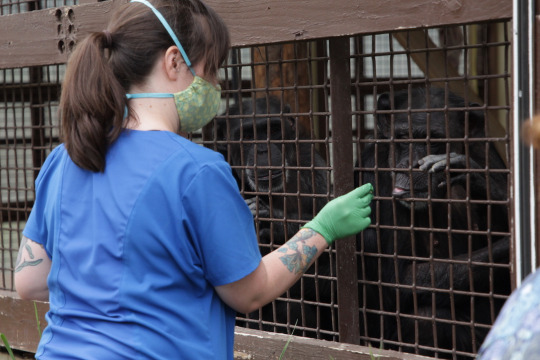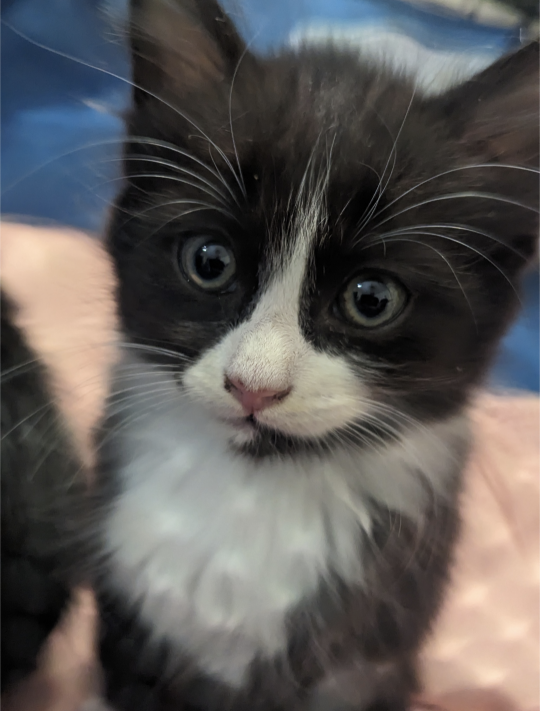#animal enclosure mesh
Text
Zoo Mesh: The Perfect Solution for Animal Enclosures

As animal lovers, we all want to ensure that our furry friends are safe and secure in their enclosures. Whether it's for a zoo, aviary, or any other animal enclosure, choosing the right mesh is crucial to ensure the safety and well-being of the animals. That's where Hebmetalmesh comes in - we are a factory that specializes in providing high-quality zoo mesh, animal enclosure mesh, and aviary mesh. In this blog post, we'll explore the benefits of using Hebmetalmesh products for your animal enclosures.
Why Choose Hebmetalmesh?
At Hebmetalmesh, we understand the importance of providing a safe and secure environment for animals. That's why we use only the highest quality materials to manufacture our products. Our zoo mesh, animal enclosure mesh, and aviary mesh are made from stainless steel wire rope, which is strong, durable, and resistant to corrosion. Our products are also designed to be flexible and easy to install, making them the perfect solution for any animal enclosure.

Benefits of Using Hebmetalmesh Products
Safety: Our zoo mesh is designed to be strong and durable, ensuring that animals cannot escape from their enclosures. It also provides a barrier between animals and visitors, ensuring the safety of both parties.
Durability: Our products are made from stainless steel wire rope, which is resistant to corrosion and can withstand harsh weather conditions. This ensures that our products last longer and require less maintenance.
Flexibility: Our products are designed to be flexible and easy to install, making them the perfect solution for any animal enclosure. They can be customized to fit any size or shape of enclosure, ensuring a perfect fit every time.
Aesthetics: Our zoo mesh is not only functional but also aesthetically pleasing. It provides a clean and modern look to any animal enclosure, enhancing the overall appearance of the exhibit.
Products Offered by Hebmetalmesh
We offer a wide range of products to suit any animal enclosure needs. Our products include:
Zoo Mesh: Our zoo mesh is perfect for creating enclosures for large animals such as lions, tigers, and bears. It is strong and durable, ensuring that animals cannot escape.
Animal Enclosure Mesh: Our animal enclosure mesh is designed for smaller animals such as monkeys, birds, and reptiles. It provides a safe and secure environment for these animals.
Aviary Mesh: Our aviary mesh is perfect for creating enclosures for birds of all sizes. It is designed to be strong and durable, ensuring that birds cannot escape.

Recommendation
At Hebmetalmesh, we take pride in providing high-quality products that are designed to meet the needs of our customers. We believe that our zoo mesh, animal enclosure mesh, and aviary mesh are the perfect solutions for animal enclosures of all kinds. We recommend our products to anyone who is looking for a safe, durable, and aesthetically pleasing solution for their animal enclosures.
Conclusion
Choosing the right mesh is crucial to ensure the safety and well-being of animals in their enclosures. At Hebmetalmesh, we offer high-quality zoo mesh, animal enclosure mesh, and aviary mesh that are designed to meet the needs of our customers. Our products are strong, durable, flexible, and aesthetically pleasing, making them the perfect solution for any animal enclosure. We recommend our products to anyone who is looking for a safe and secure environment for their furry friends.
More Ideas
ZOO MESH – A BETTER ZOO ENCLOSURE AND AVIARY NETTING
Types of Zoo Mesh Order with Different Panels and Meshes All In One
Black Oxide Zoo Mesh Order with Different Panels and Meshes All In One
#zoo mesh#aviary mesh#zoo fencing#animal enclosure mesh#Animal fence#Aviary wire mesh#Aviary netting
43 notes
·
View notes
Text



as anyone who knows me will know, my house is a zoo i am a sucker for small rodents, especially guinea pigs and hamsters. last year for my 17th birthday i shared these deco guinea pigs, so this year today, for my 18th, have the natural progression of that post: a 4t2 conversion of @kaisosims' rodents pack! 20 new, modular, decorative fur-baby items & accessories for your sims to adore 🥰
everything that could have fitted slots has slots; the hamster shelf, notably, has a grand total of 15! all of the cages are stackable, i.e.: you can put the animals (which are purely deco) in them, then stack them on top of any other surface--the given ones, or a counter, study table, etc.! more info can be found under the cut 👇
this set was originally supposed to be my... wow... 1000 followers and 17th birthday gift. but back then my cc skills honestly kinda sucked and the slots + transparency drove me to insanity. over a year, 1500 more followers, and a mental crisis later, here we are, with the final product of over 30 hours of hard work! 👏 in any case, thank you all so much for 2500 followers!
tysm to @skittlesplays for suggesting this set in the first place btw, you know me so well anna!! if you'd like to see my other, mechtasims pet set, which i converted in her honour, check out my 1000 followers gift weekend starting here.
DOWNLOAD: SFS | MF 🐹
credits go to @kaisosims for the original ts4 meshes & textures, they are so adorable! and of course to all of you, for sticking with me through another birthday 💖
DESCRIPTION
Originally by Kaisosims for TS4. Converted to The Sims 2 by nonsensical-pixels.
THINGS TO NOTE
Pretty much everything that can have a slot, has a slot!
All cages can be placed on other surfaces, like tables, counters, etc.; if you want to place an animal inside of them, do that first, THEN place them on the surface.
Everything is decorative; nothing is functional… yet.
Art pieces are in the Paintings category, surfaces like the Cage Stand are in Surfaces -> Misc, and everything else is in General -> Pets.
You may note that some items have drastically different polycounts from the TS4 originals; this is because TS4 automates the appearance of backfaces, but TS2 doesn't recognise them, so I had to add my own.
ITEMS INCLUDED
Art (28 polys)
Cage Stand (398 polys)
Cleaning Supplies (424 polys)
Ferret (682 polys)
Food (100 polys)
Guinea Pig (484 polys)
Guinea Pig Enclosure (4356 polys)
Guinea Pig Enclosure Top (1008 polys)
Hamster (520 polys)
Hamster Cage (1758 polys)
Hamster Table (308 polys)
Rat (456 polys)
Rat Cage (2140 polys)
Small Cage (988 polys)
Substrate (144 polys)
Treats (1876 polys)
Tube (640 polys)
Wood Wall Art (380 polys)
Zoom Pet (341 polys)
20 items total. Collection file included for added convenience!


much love from my lil piggies: bethany, ivory, emily, and alex!! they're getting new cages for my birthday, just like my sims' piggies 🐽
once again, thank you guys all so much for the support! i wish i could've added more to this gift but i guess this weekend's content will be compensation... 👀 if there are any issues that you find with this set, please don't be afraid to let me know! otherwise, i'll see you in the next one. happy simming, and when you download this, do keep in mind,

Love,
~ Ky 💓
#sims 2 download#the sims 2 cc#ts2cc#s2cc#sims 2 cc#the sims 2#sims 2#4t2#4t2 conversion#4t2 buy#suggestions#sims 2 suggestions#happy birthday to myself#<3 <3 <3
840 notes
·
View notes
Text
Ok, now I'm really concerned that how to prevent rats isn't common knowledge like I thought it was. So, to anyone whose parents/guardians/adults didn't teach you, here's the basics of prevention*:
Rats, like you, need three things: food, water, and shelter. If they don't get these things, they don't bother sticking around. Access to food is probably the biggest draw, and the one you can do the most about.
Rats eat the same foods you do, and the same food that most pets eat. You don't want them to have access to this food, so:
Don't leave dirty dishes laying around, the smell will attract rats. Don't put leave dirty dishes in your bed room, or under the couch, or in your car, or whatever. Dishwashers are great, but if you don't have a functional one, and you're low on energy/executive function, at a minimum cover your dirty dishes with soapy water instead of leaving them out. Rats can't eat soapy food.
Work to minimize food waste, because the smell of tasty food in your compost or garbage will attract rats.
Don't put food scraps in your indoor garbage unless your garbage can is rat proof. Take it outside asap, to a rat-proof bin.
When composting, if you're composting food that would be attractive to rats (grains, fats/oils, dairy, meat) it's best to: bury the food down in the center of the pile, try out bokashi composting, or have a rat-proof composter. Generally people do tell you not to compost dairy and meat, but I do know that some people do it anyway.
Keep your grains & legumes in rodent proof-containers. Glass jars, metal trash cans, etc.
If you have dogs, put their food away at night. If you have birds or other animals that eat a seed-based diet, then it pays to make their food/enclosures inaccessible to rats as well. Cats are rat deterrents so leaving dry food out for them is probably the one exception.
Clean up spilled foods immediately.
If you have fruit trees (like those apple trees everyone has that were planted 3 or more decades ago) and notice that something besides a deer is eating them, it's really best to pick all the fruit. You probably can't eat it all, so giving it away is a good option. Compost the rotten/icky ones fallowing the advice above, or dig a hole and do some trench composting.
Rats also need water, which is another reason to make sure you don't have any leaks anywhere, and to not leave beverages out in open containers.
Beyond that, thoroughly looking around your house, inside and out, to make sure there's no access points. Vents can be covered with wire mesh, holes the size of a dime need to be patched (because mice exist, too). Keep vegetation clear from around the base of your house, and make sure there's no trees or shrubs growing close enough to your house that a rat could make the leap to your roof. Keep an eye out for tunnels near your house's foundation, because they will tunnel underneath.
Also, while I'm at it, for the love of your house's structural integrity, DO NOT store wood piles against your house. Termites people!!!
And yes, there's a reason why cats are such a common pet. Not only do they hunt rats, the very smell of a cat is enough to deter rats. Do not just get a cat for rat prevention though, only get a cat if you're going to provide it a good home and are able to take on the additional care tasks without over extending yourself. Getting a housemate that comes with a cat is a great alternative to getting your own cat (and I'm only halfway joking).
*because prevention is much easier and much less terrible than dealing with an infestation. Prevention is so, so, so much easier than getting rid of them, particularly because once they're there, they'll start eating other things that wouldn't have been enough by themselves to draw them in.
464 notes
·
View notes
Text
Arrest made after Dallas Zoo events, including the theft of two tamarin monkeys:
Davion Irvin said he loves animals and that if he’s released from jail, he would steal more, the documents said.
Irvin, who remained jailed Tuesday on $25,000 bond, was arrested last week after asking questions at a downtown Dallas aquarium about animals there. He is charged with six counts of animal cruelty and two counts of burglary.

Zoo staff say the monkeys have lost weight but are unharmed.
Irvin told police that on the night of Jan. 29, he waited until dark, jumped a fence to get onto zoo grounds, cut the metal mesh of an enclosure and took the two emperor tamarin monkeys, according to arrest warrant affidavits . He then got on the city’s light rail before walking to the vacant home where he said he kept his animals.
Irvin has been charged in two of the odd events over a span of several weeks at the zoo and is linked to another, police said. In the taking of the monkeys, Irvin faces one count of burglary and six counts of animal cruelty — three for each monkey. He also faces a burglary charge in relation to the escape of a clouded leopard named Nova, who was discovered missing Jan. 13. A cut was found in her enclosure, and the zoo closed as a search was launched. She was found later that day near her habitat.

Irvin told investigators that he’d wanted to take Nova but that he was only able to pet her before she got on top of her enclosure, an affidavit said.
Police said have said they are still investigating, but Irvin has not been linked to the suspicious death of an endangered vulture at the zoo in January.
Meanwhile police in Louisiana announced the arrest Tuesday of a 61-year-old man in the case of 12 squirrel monkeys that were discovered missing Jan. 29 from their enclosure at Zoosiana in Broussard, about 60 miles (96 kilometers) west of Baton Rouge.

Police said the missing monkeys haven’t yet been found.
Source
1K notes
·
View notes
Text
The Fall of the House of Usher: How about that chimp attack?
WARNING for discussion and explicit description of fatal chimp mauling, and pictures of fake gore.
Out of all of the unique and gruesome deaths that occur in Mike Flanagan's Netflix miniseries, I of course took particular notice of the mauling in episode 3; "Murder in the Rue Morgue".
In this episode, Camille L'Espanaye investigates her sister's laboratory where chimpanzees are being used as test subjects for an experimental medical implant. While taking pictures of the lab Camille comes face to face with one of the chimps, who attacks and mauls her to death. So how accurate is this?
While the chimpanzees in this scene are computer generated animation (which is the popular and ethical way to have primates in film), the depiction is largely accurate. It is not at all unlikely that a chimpanzee would maul a person in this setting and circumstance, or indeed in general.

Any setting with captive chimpanzees is attuned to how dangerous they can be even when treated ethically. Chimpanzees are several times stronger than humans and aggression and fighting are natural parts of their lives. As such, chimpanzees are separated from humans by metal mesh to ensure interactions are safe. Here's an example from Chimp Sanctuary Northwest, a very high quality sanctuary:

The chimpanzees are separated from humans by metal mesh barriers with gaps large enough to fit fingers through, but small enough that they couldn't reach through and grab a person, object, or clothing. This way the human caretakers can still interact with the chimps, but the danger is greatly reduced. Wearing scrubs, gloves, a mask, and keeping hair and loose items secured also reduces the risk of danger and are commonplace in primate caretaking. For contrast, this is the lab Camille enters:

These bars are not only spaced so that a chimp could easily reach through and grab a person, but the narrow shape of this room is such that there would actually be very few spots a person could walk or stand where a chimp couldn't grab them. This is definitely not regulation and extremely dangerous, and even if the chimpanzee that mauled Camille didn't make it outside the enclosure it still could have plausibly killed her. Narratively speaking the Usher family is established to violate rules and regulations, including vital health and safety protocols, so it isn't a reach to assume that this lab would not adhere to safety standards.
It is correctly pointed out in this episode that using chimpanzees as test subjects in biomedical research ended in 2015, but it is explained that the Usher family was able to get exemption for the research undertaken at this lab. As such, up to this point I found the episode to be satisfactory in its accuracy.
There is however, one big inaccuracy I couldn't ignore.

Chimpanzee maulings are notoriously brutal. Both chimp-on-chimp incidents and chimpanzee attacks on humans are extremely disturbing. When chimps attack to maim and kill they target the hands, genitals, and faces of their opponents, and cannibalism is common both during and after fatal attacks. Combinations of beating, tearing, and biting both in the initial attack and to the body afterwards mean that many chimp attack victims are rendered all but unrecognizable. While the chimp mauling in The Fall of the House of Usher happens off screen, the audience is shown the aftermath (above) and Camille's body, which is almost entirely obscured by the blood. Later, Camille's body haunts her father which allows us to get a clear look:

As strange as it sounds to say, I was disappointed! After being mauled to death late at night, Camille's body stayed in the lab for several hours until the scene was discovered the next morning. In the initial attack and the hours to follow, it would be very unlikely that her corpse would have even a partially intact face or hands. I will not be including photographs or links to actual chimp mauling victims, but Charla Nash who famously survived a chimp mauling was left with only a few fingers and required a face transplant as her eyes, nose, and jaw were destroyed. After several hours I would expect that Camille's body would have no face or hands, and severely torn clothing.
The chimpanzee attack, like many of the events in this show, have supernatural elements. Obviously not everything has to be perfectly accurate, but I think it would have been an asset not only in building the horror, but from a literary analysis perspective. Kate Siegel (the actress who plays Camille) said in an interview "I would say in the moment my face is removed, that would be the pinnacle of my character", and I have to agree. As the public relations coordinator for the Usher family, Camille controls the metaphorical face of the family, and her hands are the ones that pull the figurative strings. Making it obvious that not only did she meet her end as a result of trying to pull strings and manipulate the family image by digging into the lab, but that the result was the mutilation and loss of her own face and hands could have been not only horrific but a terrific literary device.
Accuracy rating: 8/10
#fothou#tfothou#mike flanagan#kate siegel#tfothou spoilers#chimps#chimpanzees#apes#great apes#camille l'espanaye
86 notes
·
View notes
Note
Hello! I have a garden snail that had lots of babies and was hoping for some advice please! :) I want to make their enclosure as comfy as possible for them but I don't know how. Do they prefer dark environments? Hidey holes? What kind of substrate is best? Etc. Thank you!
(I'm in Southern California)
Congrats on your snabies! Firstly I would not take any substrate or decor for the tank from outside unless you want a lot of hitchhiker creatures in your snail tank. If you do, you'll want to bake it first.
A standard 10 (or larger) gallon aquarium with a mesh lid works great, but you'll want to modify the lid to cover most of the mesh to keep the inside humid. I just bought a squeeze tube of silicone and attached some plastic sheeting inside the lid to cover about 75% of the mesh.
Substrate can be any sort of animal-safe soil-like substrate - so soils meant for bioactive reptile and amphibian enclosures or for isopods. Repti-soil, Creature Soil, organic potting mix, etc. I personally have my snails in with my millipedes, and use a combination of eco earth and Josh's Frogs milli mix - can't recommend milli mix enough! Josh's Frogs ABG mix or isopod substrate would also be appropriate.
No matter which soil you choose, it should be 4-5 inches deep both to hold humidity and for burrowing. 10 quarts will fill a 10 gallon aquarium to the proper depth.
As for decor, I would avoid rocks since snails WILL climb the glass and other decor and probably will fall off from time to time. Rocks can shatter their shells. I would stick to wood - any aquarium safe wood is fine. Cork bark, mopani, spider wood, etc. I'd also recommend some dry/dead reptile-type sphagnum moss to keep up humidity and for nibbling, and some kind of leaf litter - I buy bags of dry/brown live oak leaves on amazon for pretty cheap. My snails don't seem to hide in holes or crevices much - when they're not active, they mostly hang out on the lid or the top glass of the tank.
You do not need lighting or heating unless your house gets particularly cold in the winter - they may be less active if it's too cold. You can put a low watt reptile heating pad on the side of the tank to keep the temp up around 70+ if need be. They are primarily active at night, so if you want to see what they're up to, a small light that doesn't give off heat near the tank would be okay.
Most important is humidity. Get all of the substrate and moss damp as you put it into the tank with distilled water. I use a reptile mister bottle and buy gallons of distilled water at the grocery store. They last a long time so not a big investment. You'll also have to mist the whole enclosure probably daily, maybe twice daily. It should be moist and humid but not sopping wet. Don't let the substrate dry out entirely. Occasionally you may have to stick your finger into the soil to make sure it's staying damp under the surface.
And finally, snails need calcium for their shells! I occasionally dust the top of the substrate with powdered reptile calcium, or you can throw a cuttlebone in there for them to nibble on.
Here's a list of safe/not safe foods for snails.
If you ever have more questions about setup that I didn't answer here, feel free to IM me! Happy to share creature keeping tips.
76 notes
·
View notes
Note
I’ve heard that chameleons have a very high mortality rate in captivity and are very challenging to keep as pets. Why is that? I wouldn’t intuitively guess they’re that hard to keep, I mean they seem pretty chill
Chameleons are difficult to keep to the point where I believe it's unethical to keep them in captivity. They indeed have a very high captive mortality rate.
Here's why chameleons make bad pets:
They're incredibly fragile. They get sick very easily, and a common injury in pet chameleons is broken bones from being handled too roughly. It's difficult to overstate how fragile these animals are.
They need a warm, extremely humid enclosure with high airflow. Their enclosure must be made of mesh, and it's crazy hard to keep humidity up in a mesh enclosure.
Most are wild-caught. Wild-caught chameleons, on top of illness from stress, are often dealing with parasites and injury.
Their care is specific and non-intuitive, even if you have reptile experience. Their enclosures need running water, they need a highly specific calcium:phosphorus ratio in their diet, they need very frequent misting to keep their enclosures humid enough without causing humidity spikes that will make them sick, their body language is difficult to read even if you're familiar with other lizards, and, once again, they are incredibly fragile. It's easy to miss signs of stress until it's too late, and there's just not time to misinterpret what they're telling you.
They are absolutely "look but don't touch" pets. Handling can stress them out far too much, and, not to harp on the point, but they're fragile enough that handling can hurt them badly.
Chameleons have such a high mortality rate - it's no exagerration to say that the majority of pet chameleons will die within months, if not weeks - that I don't believe they should be in the pet trade at all. The herpetological association I partner with actually has classes where we take people through care of our rescue chameleons to show them what it involves, and most people back out. They're pets you will want to rearrange your life around to keep them healthy.
Chameleons are cool, but they belong in the wild and at accredited zoos with the resources to care for them properly.

304 notes
·
View notes
Note
So I saw that Nugget had the zoomed hammock and I got one for my crestie and I was a little worried about the nails but my mom commented how they are extremly tiny, I also asked a disc server I was on and a few said their claws would get ripped out and it can harbor bacteria(I know the woven ones can but i dont think the green mesh like ones can) and I just wanted your opinion because my crestie really likes a big platform but there's not many out there, I've also seen other crestie keepers have it and I just don't want him to get hurt. Thank you!
Hi there! So both the woven hammocks and the green ones are safe, if the nail health of the animal is taken care of :) That fairly new misinformation comes from a vet facebook group where a beardie with incredibly overgrown nails got snagged on it and ripped the nail out, but all the people saw was 'hammock rips out beardies nail'. When the nails are well kept and trimmed (or naturally filed down) There is no risk of snagging. Just like dogs with overgrown nails are at risk of ripping them out, but well groomed dogs aren't at the same risk. Animals such as geckos that have shorter nails (Cresties, leachies, etc) will be perfectly fine on them :)
This isn't directed at you, but the reptile community for sure needs to do better on communicating the whys of things like this. Loose substrates for lizards are viewed as dangerous, when its the care that matters (Unless its calci-sand or ground walnut shells, which are just dangerous in general), water bowls are seen as dangerous for beardies when its the cleanliness of the enclosure that matters, etc. People blame one thing (loose substrate on impaction, when its actually too low temperatures, RI's on water bowls when its the bacteria from a dirty enclosure and low temps, etc) when its actually something else that has to do with their care, but they don't want to admit it, so it turns into misinformation.
ANYWAYS yeah sorry went off on a tangent there lol.
TL;DR
Hammocks are safe :)
15 notes
·
View notes
Note

[ID: a close up photo of a black and white kitten who is sitting down, staring past the camera with wide green-blue kitten eyes against a peach and blue fabric background. There is a subtle wave of light colored distortion on the lower half of the photo. End ID]
Here's an adorable little rescue kitten for your troubles. Her name is Gizmo, she's one out of four feral kittens + their mom we rescued on the Fourth of July, and she's the most photogenic of her siblings. Every photo she's in shes got these big olde anime eyes. This photo is not edited or filtered in any way, I just happened to be taking a picture of her through the mesh net of the pop up kitten enclosure we got and it made a very fancy little, subtle light show.
Its dangerous to go alone, take a kitten pic with you :)
wait this looks like—
20 notes
·
View notes
Note
Hi! I love your blog and your bugs. My partner dug up an old terrarium and really wants to get a beetle or stick insect to put in it—basically something big and solitary but also vegetarian so we don’t need to feed it other bugs. Do you know where the best place to get a beetle or stick insect would be? And are there any common pitfalls of bug ownership we should avoid?
depends on where you live—I’m in the US, and most exotic beetles and stick insects aren’t legal to import, and the native species are not often bred.
depending on what you mean by “terrarium” the enclosure may not be suitable for either animal, as stick insects do best when kept in tall mesh enclosures where they can be fed branches of their hostplants and molt safely.
you might be better off getting a lone male Madagascan hissing cockroach—they are longer lived than either beetles or stick insects, easier to feed, and active enough that you won’t just be looking at bare dirt.
35 notes
·
View notes
Text
As reports of other incidents are beginning to come in, I thought I’d make a thread on all the crazy break-ins going on in the zoo world since the beginning of 2023.

On January 13th, Dallas Zoo closed due to a loose clouded leopard. Within hours she was discovered close to her home and safely returned to her enclosure with her sister, who had not left. Her wire mesh fence was discovered to have been intentionally cut open.

The next day, January 14th, it was announced that another cut had been discovered in the Dallas Zoo’s spectacled langur exhibit. However, the monkeys did not leave their enclosure and all were reportedly accounted for and uninjured.

On January 22nd, a highly endangered lappet-faced vulture at the Dallas Zoo was found dead in his enclosure with a “suspicious wound.” The wound appeared to be unnatural and is suspected of being a stab wound.


On January 29th keepers at Zoosiana discovered that 12 of their squirrel monkeys were stolen in the night. The remaining monkeys were uninjured but stressed.

On January 30th, attention was back on the Dallas Zoo as it reported that two of its emperor tamarins were missing after their enclosure had been cut into. As Dallas was in the middle of a freeze, it was doubtful the monkeys would have left their heated enclosure willingly. They were believed to have been taken.

On January 31st, Dallas police released photos and a video of a person of interest who may be connected to the theft of the tamarins.
Later that day, the tamarins were found in an abandoned home following a tip from the owners of the neighboring church. The monkeys were in a closet filled with bird feces and moldy clothes. Police also found cats, cat feces, pigeons, and a water jug containing dead fish in the home.
The tamarins were reportedly very happy to return to their warm home, but had lost weight. The zoo currently has them in quarantine to get their weight back up and monitor them for any illnesses they could have caught from the other animals in the abandoned house.
On February 2nd, 24-year-old Davion Dwight Irvin was arrested after an employee of the Dallas World Aquarium recognized him from the “person of interest” photos. He was reportedly scoping out mesh enclosures at the aquarium and approached the employee to ask questions about the animals’ care.
Apparently there had been unreported thefts in early January of feeder fish and fish supplies as well as training supplies taken from the behind the scenes otter area at the Dallas Zoo.

Meanwhile, also on February 2nd, someone cut open the stainless steel mesh of the Central Park Zoo’s Eurasian eagle owl exhibit. The owl, Flaco, has been under zoo surveillance since he was located on the 3rd and the hope is to lure him back with food once he gets hungry. As of today, February 8th, he has not eaten or drank, as he does not know how to in the wild.


Back to Texas, and despite zoos in the area doubling security, on February 6th keepers found a 4-inch cut in the Houston Zoo’s brown pelican enclosure. The birds are reportedly all accounted for and unharmed.
On February 7th, it was reported that Davion had not only confessed to stealing the Dallas Zoo’s monkeys, but also stated that, if released, he would go right back to stealing animals.
Davion confessed that he had attempted to take Nova, the clouded leopard, but he was only able to pet her before she climbed out of reach. He was also linked to cutting the langurs’ enclosure, but not charged since the langurs did not escape.
It was also revealed that Davion had been a person of interest after staff recognized the zoo regular as someone who often asked a lot of abnormal questions (such as how to shift the tamarins in and out of their various spaces) and had been previously been caught sneaking into staff only areas.
So far the vulture, Pin’s, death is still under investigation. Pin’s enclosure was on the other side of the zoo from the area Davion had been targeting.
As for Zoosiana’s squirrel monkeys, an arrest has been made in connection to the theft. 61-year-old Joseph Randell has been taken in for questioning. The 12 monkeys remain missing.
As it stands, we still have one dead vulture who’s killer may still be at large, 12 missing squirrel monkeys, and an owl in danger of starvation or injury in New York City.
I will reblog with updates to ongoing cases as they become available, or if more zoo sabotage happens (God forbid). Please feel free to correct me if I’ve gotten any dates or information wrong and I will edit or update this post.
(Also, I am on mobile and won’t be able to add a readmore until I can access a computer, sorry) Update: I was finally able to add a readmore and also turned all news links into hyperlinks.
#anticap people may interact but please keep it civil#y’all are on thin ice#We dedicate our entire lives to keeping these animals safe and this is a very stressful time for keepers#who already suffer from mental issues like compassion fatigue and lock anxiety#dallas zoo#houston zoo#zoosiana#central park zoo#zoo news#zoos and aquariums#emperor tamarins#squirrel monkeys#lappet-faced vulture#dallas zoo theft#dallas zoo monkey theft#dallas zoo leopard#dallas zoo clouded leopard#dallas zoo vulture#dallas zoo monkeys#dallas zoo emperor tamarins#zoosiana squirrel monkeys#zoosiana monkeys#central park zoo owl#flaco owl#owl flaco#long post
45 notes
·
View notes
Text

$472 - $1585
4in x 4in Animal Fencing Animal Barrier Fence Panel 10' x 60' Roll Animal Enclosure Netting Stainless Steel 304
Looking for a way to keep those pesky animals out of your garden? Look no further than 4in x 4in animal fencing! This fencing is so effective, you'll be able to keep out even the most determined critters. Want to know how it works? Well, it's simple really. The 4in x 4in squares are just too small for most animals to squeeze through. And if they try to climb over? Good luck with that! The fencing is so tall, they'll need a ladder just to get a peek at your veggies. Plus, let's be real, it's pretty funny watching squirrels and rabbits try to figure out how to get past it. So, if you want to protect your garden and have a good laugh at the same time, 4in x 4in animal fencing is the way to go!
0 notes
Text
Axolotl's as pets
Despite being endangered, Axolotls are gaining a quick market as pets. whether or not this is good will be covered in a later post but for now we're talking about Axolotl's as pets,

Axolotl Behaviour and Temperament
While axolotls are relatively hardy to slight fluctuations in their environment, they also have delicate, soft bodies with permeable skin. In fact, most of their body is made of cartilage rather than bone. That means they should not be handled unless absolutely necessary. And if you do have to move them out of their tank, do so with a fine mesh net that won't entangle any of their body parts.
Once you have their housing setup correct, you generally only have to spend a few hours per week on feeding and cleaning. The rest is simply enjoying them as a quiet, aquatic companion. Axolotls tend to be fairly bold and are perfectly content to move about their tank as they're being watched by their humans. Some will come up to the side of their tank when a person is there observing them.
However, they aren’t particularly social animals and don’t require any tank companions. They should not be kept with other species as axolotls might try to eat pet fish, and the fish sometimes nip at them, as well. You even should be cautious about housing them with other axolotls. Juvenile axolotls can be cannibalistic toward one another, so they are best raised in separate enclosures. Adults can potentially be housed together, but still, watch out for cannibalistic tendencies. If a body part gets bitten off by a tank mate, an axolotl actually can regenerate it over time. However, it's still best to avoid this situation altogether.
Housing the Axolotl
At least a 15- to 20-gallon fish tank is recommended for axolotls. Make sure the tank has a secure lid, as it's not uncommon for these animals to try to jump out of their enclosure. A land area is unnecessary in the tank for these fully aquatic animals. At a minimum, the water depth should be slightly more than the length of your axolotl. But adding extra depth will help with water quality and give your animal more room to move.
Keep the tank in a cool room away from bright sunlight with the water temperature between 57 and 68 degrees Fahrenheit (14 and 20 degrees Celsius); don't allow it to get above 75 degrees Fahrenheit (24 degrees Celsius). No special lighting is required for axolotls (unlike many reptiles). In fact, a dark hiding spot, such as a flower pot laid on its side or an aquarium castle, is often appreciated.
Some owners opt to leave the bottom of the tank bare, though others believe this might stress the axolotl if it can't get a foothold on the smooth bottom. If gravel is used on the bottom, it must be coarse gravel that's bigger than the axolotl's head. Fine gravel might be ingested and cause an obstruction.
Tap water treated with an aquarium water conditioner that removes chlorine and chloramines is fine for axolotls. Never use distilled water, and make sure the pH of the water remains between 6.5 and 7.5. (You can find a water test kit to check at most pet stores.) Most owners find a filtered aquarium is easier to maintain because unfiltered water needs frequent changing to remove waste. However, if you choose to have a filter on the tank, the filtration rate should be slow. Powerful filters that create strong currents can stress an axolotl.
For a filtered tank, cleaning typically consists of a 20% water change each week, as well as siphoning waste from the bottom of the tank. If you're not using a filter, you likely will have to do a 20% water change daily or every other day. Never do a full water change, as this can alter the water chemistry too drastically and stress your Axolotl.
Food and Water
In the wild, axolotls feed on snails, worms, crustaceans, small fish, and small amphibians. In captivity, they can be fed a variety of brine shrimp, small strips of beef or liver, earthworms, bloodworms, tubifex worms, other frozen fish foods, and commercial fish pellets. Do not feed any worms or fish you caught yourself, as they can carry parasites. In general, no vitamin or mineral supplements are necessary.
Consult your veterinarian regarding the amount of food to offer, as well as how often to feed your axolotl, as this varies depending on age and size. In general, many adults take two to three feedings per week. One of the best methods to feed is by holding the food in round-nosed forceps in the tank near the animal. You also can simply drop the food in the water as close to the axolotl as possible. If your axolotl isn't interested in eating much during the day, try feeding it in the evening when it's typically more active. Remove any uneaten food from the tank every day to keep the water clean.

Common Health Problems
A notable characteristic of axolotls is their regenerative powers. In the case of injuries that aren’t life-threatening, they’re able to regrow their limbs, tail, and even other body parts, such as heart and eye tissue.
But this remarkable ability doesn't protect them from all health issues. Unsanitary tank conditions can lead to viral or bacterial infections, the signs of which include lethargy and a lack of appetite. Plus, ammonia build-up from waste in the tank can be toxic. If this occurs, it can interfere with the respiratory process causing damage to the gills as well as result in neurological damage.
Moreover, axolotls with gravel in their tank that's small enough to eat are prone to gastrointestinal obstructions. If your axolotl experiences an obstruction, it will likely be sluggish and not want to eat. And if it's not promptly treated, death can occur quickly.
Furthermore, axolotls rarely do undergo metamorphosis into a terrestrial form. The reasons for this are poorly understood, though it might have to do with hormones or water characteristics. The metamorphosis can be extremely stressful for an axolotl, and it can significantly shorten its lifespan. If you notice abnormal changes to your animal's body, such as it starting to grow larger, have a veterinarian who specializes in exotic pets examine it as soon as possible.

(Photo of unhealthy Axolotl)
Purchasing Your Axolotl
Always acquire an animal from a reputable breeder or rescue group. It's best not to buy an axolotl through the internet or a classified ad unless you've spoken directly with the seller, and they're able to provide you with adequate information on the animal. If they can't give you thorough documentation on its origin and health history, that's a red flag. It's also ideal to speak with people who have acquired animals from that seller to uncover any concerns. Plus, a local exotic veterinarian often can direct you to a good breeder or rescue.
Expect to pay between $20 and $70 on average. Animals with more rare coloring, such as copper, tend to cost more. A healthy axolotl will be active, and it might accept food if you offer it. Its skin shouldn't be flaky, and its body should be somewhat plump (as opposed to underweight), though it shouldn't have any abnormal swelling.
All information above was sourced from The Spruce Pets
16 notes
·
View notes
Text
As A Velociraptor Should Do
Wrote this for an English project, can't believe I forgot to post it here!
Summary: A velociraptor makes a daring escape from a research facility! Freedom is all hers, if she wants it.
Rating: E
Length: 1500 words
CW: blood mention, animal death (raptor goes hunting)
The smell of grass and wildflowers lingered for longer than Sierra expected. In spite of her artificial surroundings, the raptor knew the scent well; her researcher/caretaker liked fresh air while he worked, so long as Sierra was secure in her enclosure. This time, however, the smell of the outside world persisted even after Avi left the surrounding room. Sierra put the pieces together: the scent meant an open window, an open window meant a passage to outside, to the forest she’d seen only through glass, and the forest meant hunting, and freedom, and very clever ambushes. And without Avi to catch her before she bolted, that left only one obstacle between her and that sweet, unrestricted freedom.
Sierra knew how the door to her enclosure worked, after seeing Avi open it so many times. The handle, chest-height for him, was still too high for her biting range, even if she stretched up as tall as she could go. For a brief moment, she nearly chirped a loud help call, to try to get the human to open it for her, but the thought of having to evade him on the way to the window quashed that idea. Instead, Siera crouched, took aim, and leapt at the door, landing with a crash of talons on metal. Her claws hooked into the holes in the mesh, and she grabbed the handle in her jaws and yanked down. With a click, the door slowly swung open. Success.
After some effort to disentangle her claws from the door, Sierra once again stood on the floor of her enclosure. She ruffled her feathers, took a step out, and froze. Surely she wasn’t going to escape without her beloved stuffed raptor! Quick as she could, she turned, grabbed Nevada in her jaws, and dragged him away. The steady sound of fabric sliding on tile accompanied the rhythmic click of dino claws, as Sierra searched for the open window, following her nose. Finally, a gentle breeze wove through her feathers, and she found herself and Nevada in front of a small cabinet. It felt familiar to her, and when the raptor drew close enough to see the dent in the metal, Sierra recognized it with a wince.
It had been a few months earlier, just after finishing a round of measurements. Sierra had spotted a curious, bright red bug zipping around in front of her. Naturally, such things must be caught. However, no matter how sharp her turns or how quick her sprint, the strange insect evaded her grasp. Avi was helping, in his own way: he did not run much, himself, but with some tool in his hand, he pointed out to her where the bug was with enviable speed and precision. With her natural hunting skills and Avi’s guidance, she remained hot on its trail until it sped under the cabinet, and Sierra did not, instead slamming into the metal hard enough to dent it. The noise must have scared it off, because it was another month before she ever saw another of its kind. And at least Avi was always there to help whenever one did show up.
Recalling the thrill of the hunt invigorated Sierra; she crouched once again, clamped down firmly on her toy, and leapt at the top of the small cabinet… but came up short and fell back to the floor. Undeterred, the raptor issued a low, warning trill at the furniture and tried again. And again. After the third failure, she let go of Nevada for one last attempt. This time, without carrying around a large stuffed toy, she cleared the jump with ease. And at last, the window was right in front of her. Sierra spared a glance back down at the floor-bound doll, but soon turned away. Freedom, it seemed, held a hefty price. She felt the wind ruffle her feathers - real wind, not just the building’s ventilation - and hopped outside, flapping her arms to slow her descent.
Across the field stood a forest of deep green. Sierra’s mind filled with outrunning and outwitting foes, as well as cornering or baiting them with another raptor. Surely, she resolved, that was where she would begin that liberated life, far from tests and researchers. She walked slowly, revelling in the feel of grass under her feet. Suddenly, movement! A pair of mice picked their way through the field, apparently unaware of how easily Sierra could see them.
A rush of energy coursed through the dinosaur’s body as she stalked her newfound prey. Slowly, quietly, and with utmost focus, she crept nearer and nearer. The wrong blade of grass rustled, and the mice shot off, with Sierra in hot pursuit. With her head tucked down, her body cut through the air as her legs propelled her around the field. A well-timed lunge split up the mice, sending one back closer to the building; Sierra stayed steady on the other, but inwardly congratulated herself on the trick. If she had been hunting with a partner, that other mouse would have just become easy pickings!
At last, the mouse misstepped, or maybe simply grew tired. It hardly mattered to Sierra, who slammed a clawed foot down onto its little body. The raptor picked it up in her jaws and quickly gulped it down. She felt giddy. Her first hunt! And she could only get better. The forest was closer now, and drew closer still with each step. Soon, she would vanish from the view of that building, and truly begin her life as a free, wild dinosaur!
Just before the first trees, the ground dropped away at a sharp ledge. Sierra was not foolish enough to fall, but instead hesitated at the drop. She looked back at the building she had come from. Just one more jump, and she may never see it again. No more tests, no more wire mesh enclosure, no more stale air. The raptor crouched and readied her arms to manage her descent, but more thoughts came. No more sleeping next to Nevada. No more hunting those red bugs with Avi. The little dinosaur stood back up. No more Nevada. No more Avi. She took a step back, then shook her head, as though she could physically shake the thoughts out of it. Surely, she was not in for solitude, just something different. In fact…
Sierra took a deep breath,screeched a call into the woods, and waited for a response.
Nothing.
Just idle birdsong and the rustling of leaves and branches in the wind.
She drew in another breath, and chirped as loud as she could, calling any raptors for help. And again, in case they hadn’t heard the first time.
No response.
Sierra shivered, and her feathers stood on end. She hadn’t thought of this, when she dreamed of hunting, wild and free, that she might do it all alone. There was always a second or third raptor in her thoughts, to share food with, to protect and be protected by, to play with. The more she thought of it, the more she realized she disliked the idea of it. She knew what she would do, then. Nevada wasn’t technically alive, and Avi wasn’t a dinosaur, but they were both infinitely better than nothing. Sierra turned around; real raptors or no, she was going to live with her pack.
…right after she chased down that rabbit she just saw move.
One quick meal later, Sierra found herself staring up at the windowsill she had first leapt from. To her dismay, it was too high to jump onto, as she discovered with several failed attempts. Determined to break back into the place she had just escaped from, she looked along the wall, and soon found a lower windowsill. Even better, once she had leapt up and peered through the glass, she saw Avi sitting at some kind of machine.
Sierra chirped for help, then tapped her muzzle against the window. Avi looked her way, then turned back. An instant later, he whipped his head around again and stood up fast enough to knock his chair backwards. Avi ran over to the window, unlocked it, and pushed it open.
“Sierra, how did you get out?” he asked. Sierra ducked inside, hopped onto the floor, and trotted back to the research and testing area. Avi followed, trying to look her over. “Is that blood? Not yours, I hope.”
Paying little heed to the noises Avi made, the raptor quickly found Nevada where she had left him, grabbed him in her mouth again, and dragged him to Avi. He finally noticed the open window, closed it, scooped up Sierra and her toy, then carried her to a small basin with a water spout.
“I’m gonna have to get an actual lock now, huh,” Avi muttered as he watched Sierra splash herself clean.
Sierra responded to his sounds with a happy trill. It was settled, then: the next time she escaped, she’d have to take Avi with her.
24 notes
·
View notes
Text
there's an invasive mantis in my garden and i'm considering bringing it inside because i like mantises and i like seeing them and i've always wanted one as a pet, but i also don't want this guy attacking any native insects that come by.
the enclosure isn't that hard to put together, a mesh cage is cheap and i hear they're safer than a proper terrarium. cover the bottom with a few paper towels and maybe put in a plant for climbing and humidity, and you're good.
the problem is that they only take live food. so if you have a mantis, you'll also need to keep feeder insects. and i'm not looking to acquire multiple animals rights now ._.
2 notes
·
View notes
Note
hey, ist it possible to keep a corn snake in a tank with screen/mesh walls like for chameleons? my corn snake is outgrowing his current glass tank so I'm looking into getting a larger one. problem is, I'm pretty broke and glass tanks are expensive. I found a mesh tank in a bigger size that is way cheaper than the glass ones, is it possible to keep a snake in there or would you recommend against that?
I would not recommend mesh, I'm afraid. It's absolutely lousy for holding heat and humidity.
I always recommend PVC enclosures for adult snakes, both because they're better than glass at holding heat and humidity and because they're often cheaper than glass enclosures. If you're looking for a great budget option, check out Animal Plastics - they can have long wait times, but they're quality enclosures at very affordable prices.
86 notes
·
View notes